Abstract
Significant asymptomatic bacteriuria is a risk factor for symptomatic urinary infection and septicemia among predisposed individuals such as diabetics. We investigated the pattern of asymptomatic bacteriuria among our type 2 diabetics with a view to documenting the prevalence, type of organisms responsible and the antibiotic susceptibility pattern. One hundred and twenty-four type 2 Nigerian diabetics (55 males and 69 females) submitted midstream urine specimens for culture. Thirty-three patients had significant bacteriuria (9 males and 24 females), showing the frequency of occurrence of asymptomatic bacteriuria to be 26.6%. The most common organism isolated was Klebsiella pneumonia at 42.4%. Gram-negative bacilli made up about 23 (69.7%) of the isolates. Isolates were poorly sensitive to the readily available antibiotics (ampicillin, tetracycline and cotrimoxazole), but a large number of the organisms isolated were sensitive to nitrofurantoin, gentamicin, ciprofloxacin and ofloxacin. Sensitivity to erythromycin, nalidixic acid and cefuroxime was moderate. Asymptomatic bacteriuria is, thus, more prevalent among the Nigerian diabetic population than in the non-diabetics. A changing pattern of disease is observed with Klebsiella sp. now accounting for the majority of asymptomatic bacteriuria among diabetics. The organisms are not sensitive to the commonly available antibacterial agents.
Full text
PDF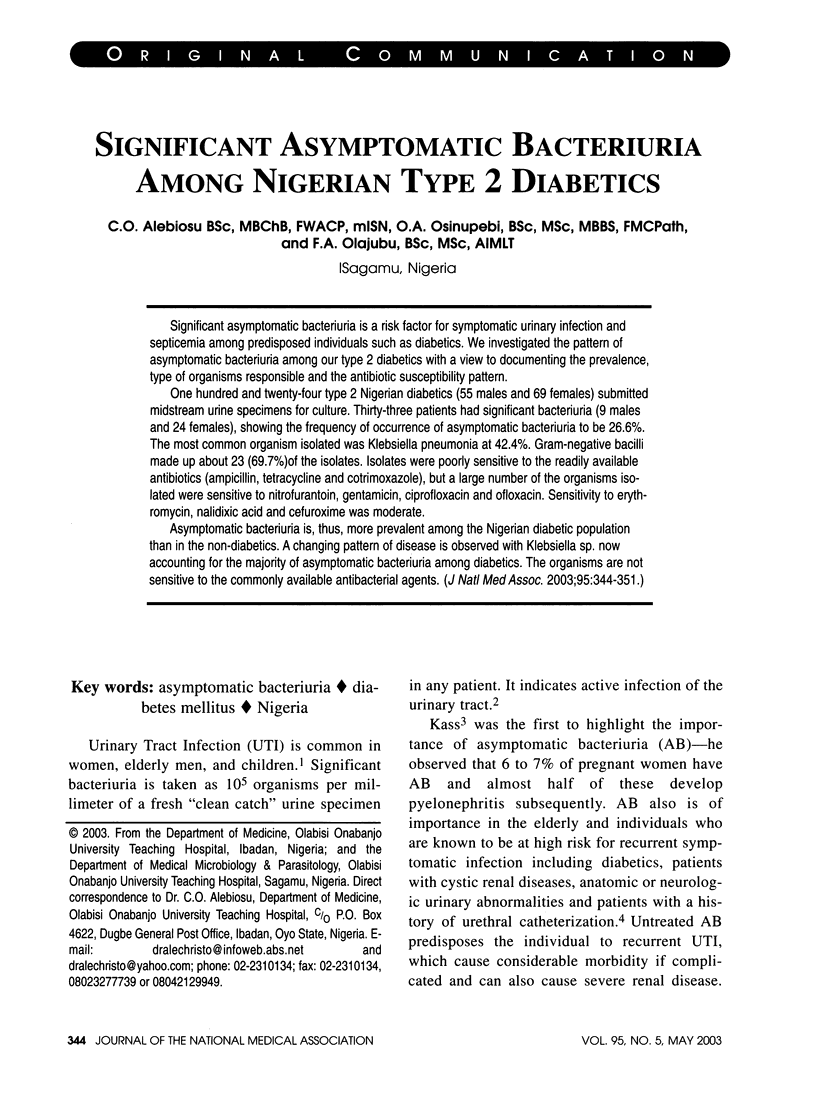
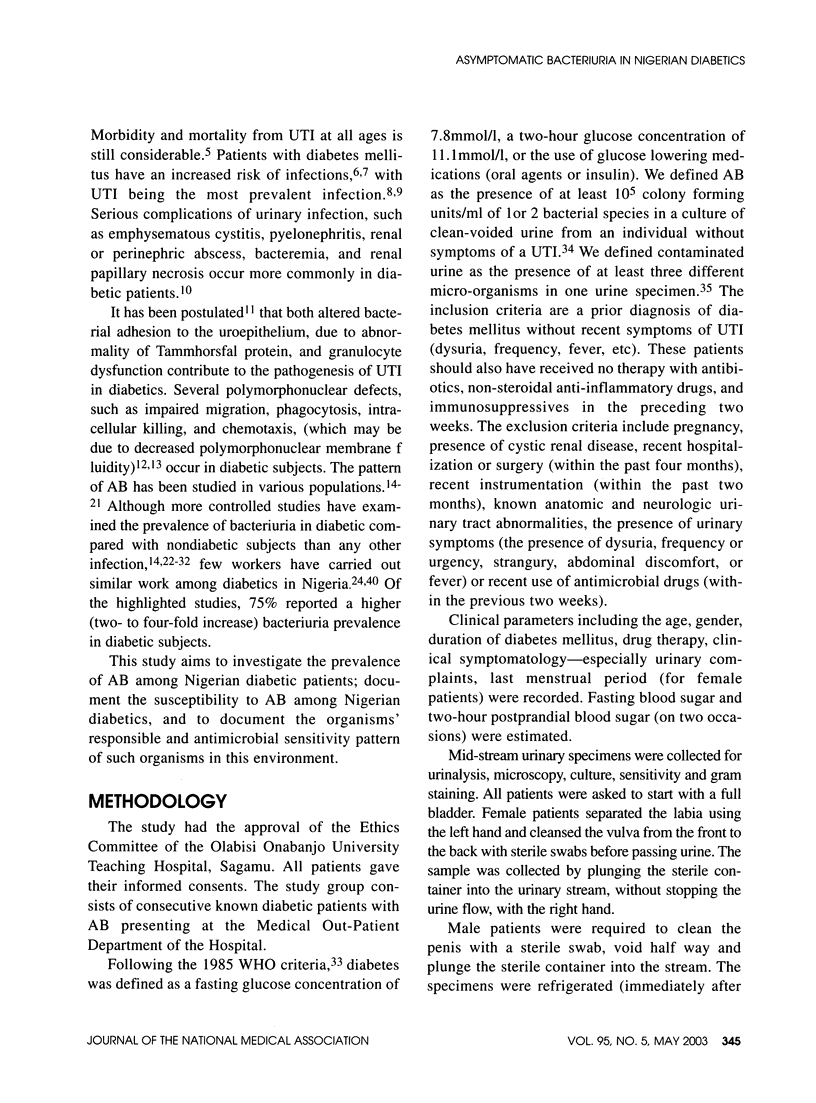
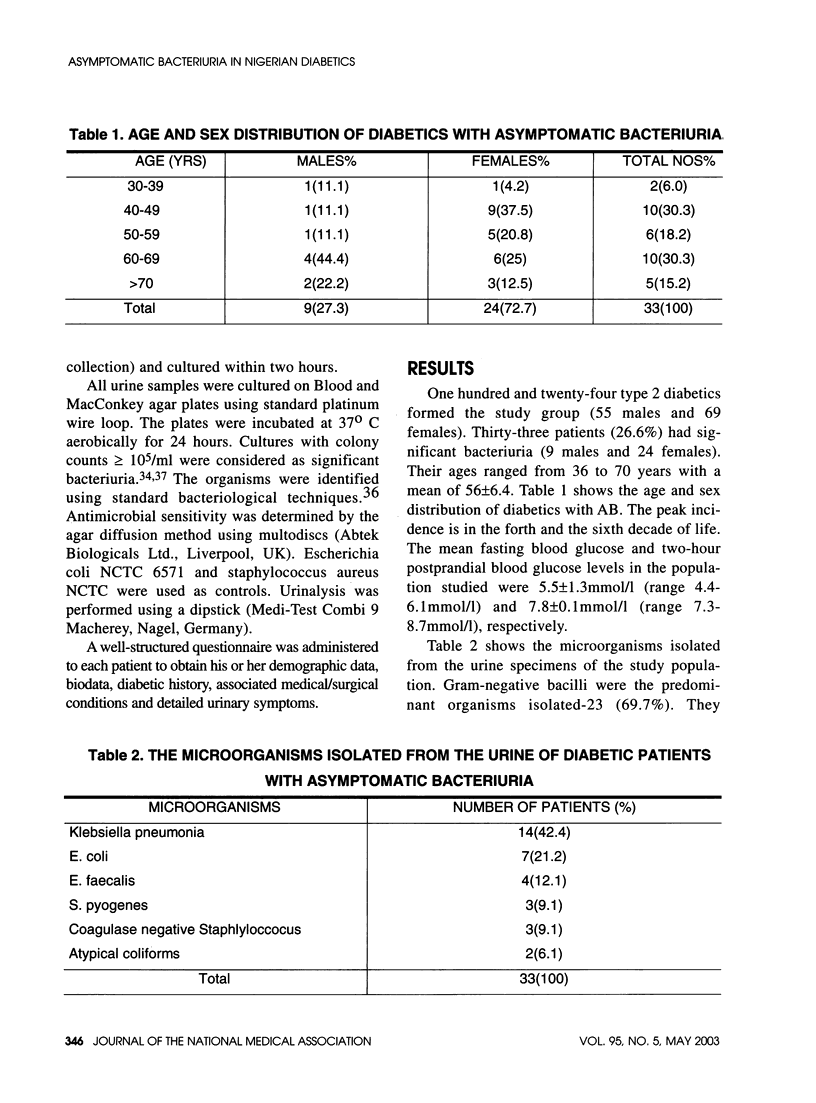
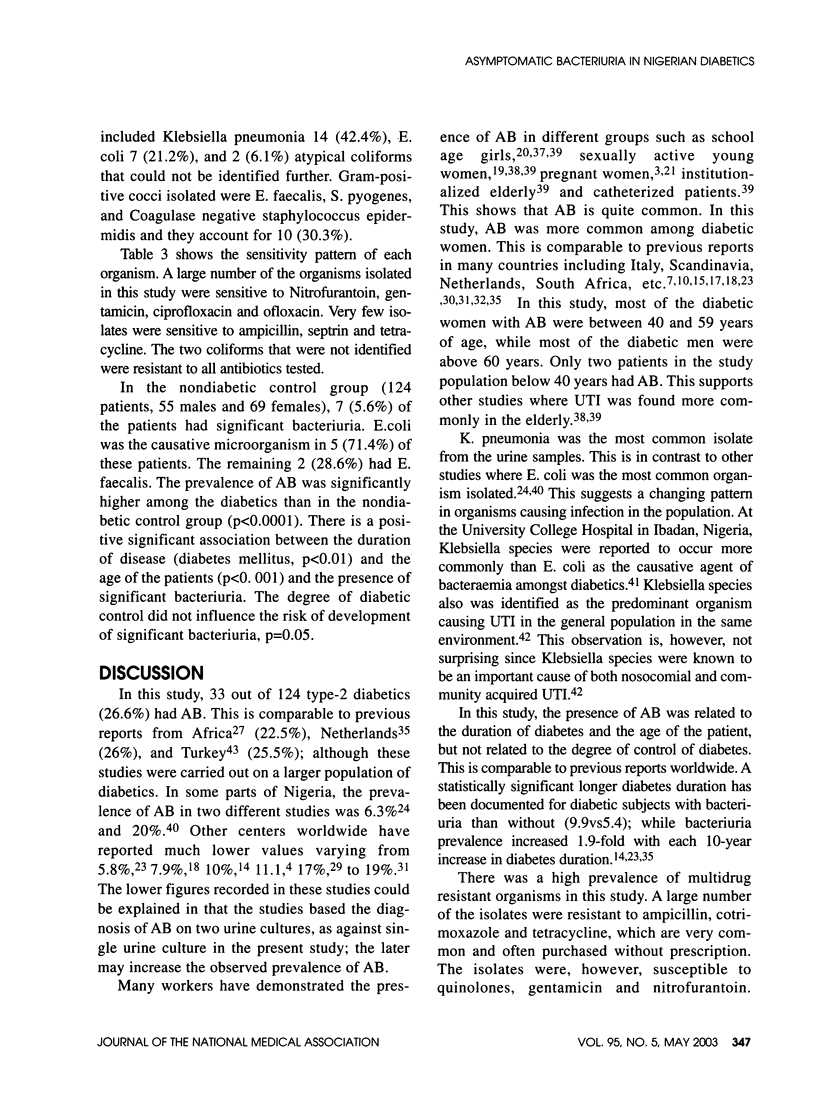
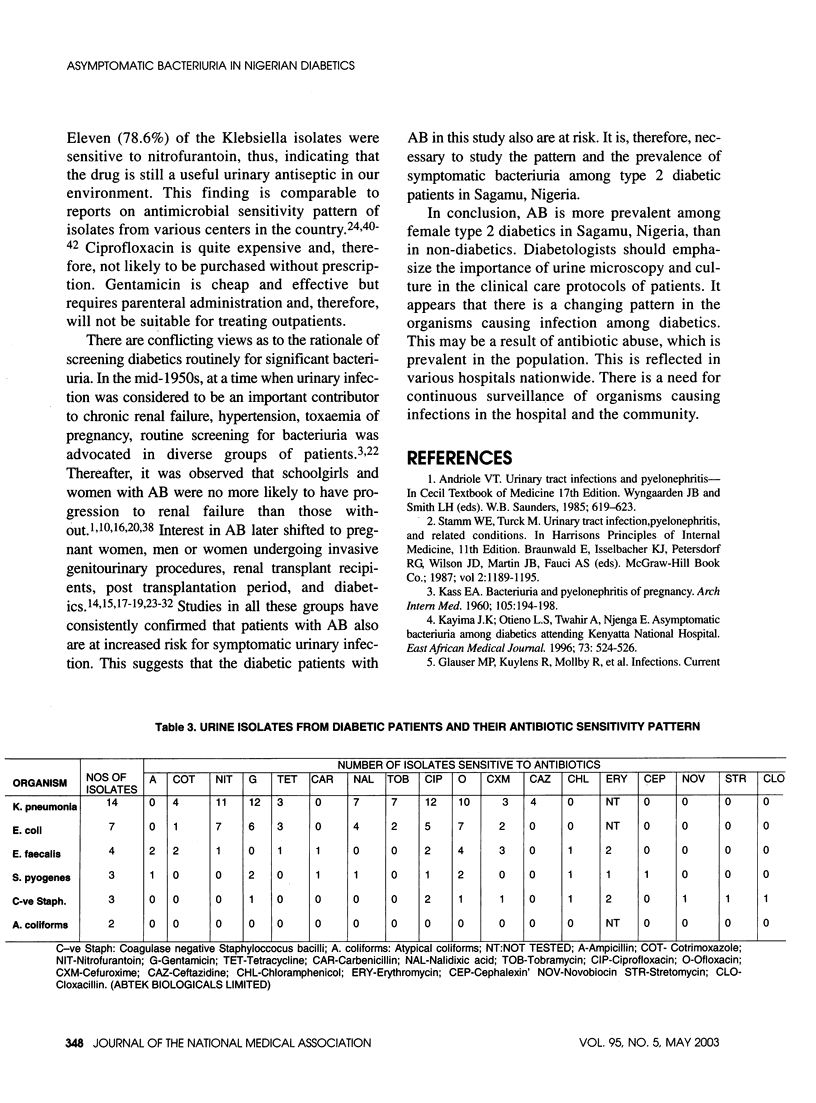
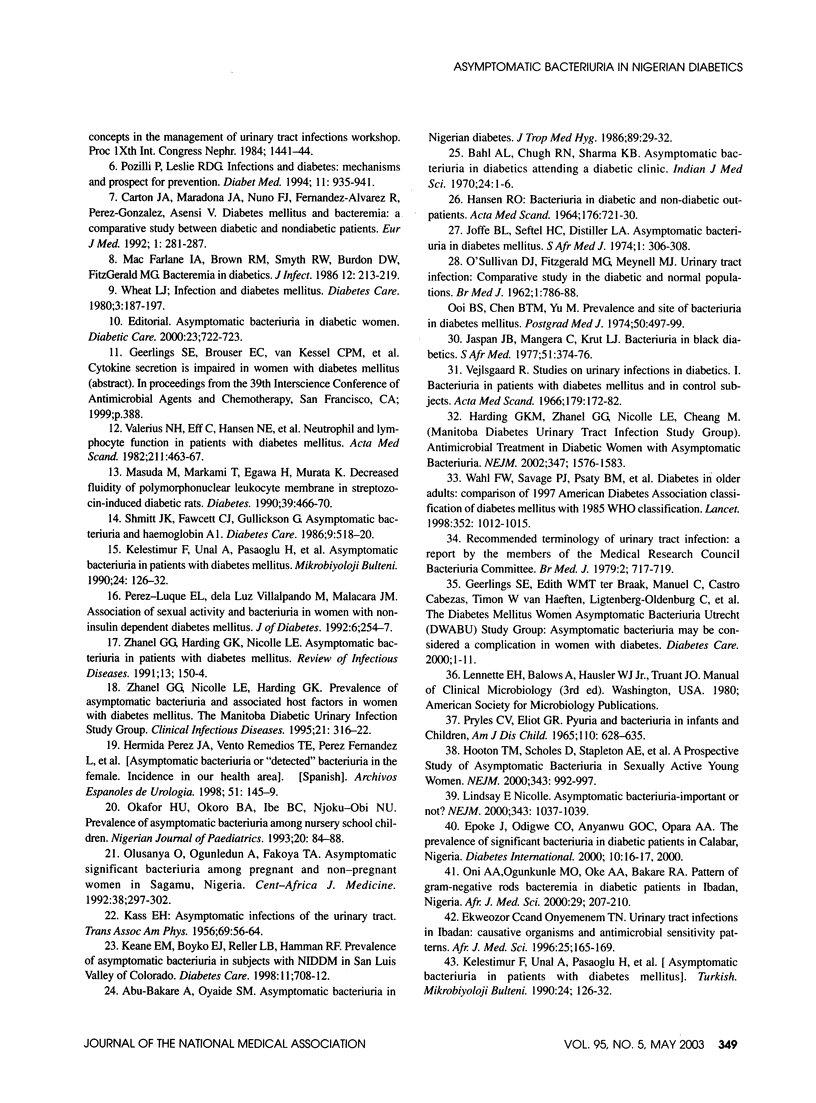
Selected References
These references are in PubMed. This may not be the complete list of references from this article.
- Abu-Bakare A., Oyaide S. M. Asymptomatic bacteriuria in Nigerian diabetics. J Trop Med Hyg. 1986 Feb;89(1):29–32. [PubMed] [Google Scholar]
- Bahl A. L., Chugh R. N., Sharma K. B. Asymptomatic bacteriuria in diabetics attending a diabetic clinic. Indian J Med Sci. 1970 Jan;24(1):1–6. [PubMed] [Google Scholar]
- Carton J. A., Maradona J. A., Nuño F. J., Fernandez-Alvarez R., Pérez-Gonzalez F., Asensi V. Diabetes mellitus and bacteraemia: a comparative study between diabetic and non-diabetic patients. Eur J Med. 1992 Sep;1(5):281–287. [PubMed] [Google Scholar]
- HANSEN R. O. BACTERIURIA IN DIABETIC AND NON-DIABETIC OUT-PATIENTS. Acta Med Scand. 1964 Dec;176:721–730. doi: 10.1111/j.0954-6820.1964.tb00680.x. [DOI] [PubMed] [Google Scholar]
- Harding Godfrey K. M., Zhanel George G., Nicolle Lindsay E., Cheang Mary, Manitoba Diabetes Urinary Tract Infection Study Group Antimicrobial treatment in diabetic women with asymptomatic bacteriuria. N Engl J Med. 2002 Nov 14;347(20):1576–1583. doi: 10.1056/NEJMoa021042. [DOI] [PubMed] [Google Scholar]
- Hermida Pérez J. A., Vento Remedios T. E., Pérez Fernández L., Acosta Lorenzo J. A., Acosta Bernad I., Calvo Azparren E., Fernández Lorenzo I., Lorenzo Hernández M., Hernández Pérez F. Bacteriuria asintomática o bacteriuria "detectada" en la mujer. Incidencia en nuestra área de salud. Arch Esp Urol. 1998 Mar;51(2):145–149. [PubMed] [Google Scholar]
- Hooton T. M., Scholes D., Stapleton A. E., Roberts P. L., Winter C., Gupta K., Samadpour M., Stamm W. E. A prospective study of asymptomatic bacteriuria in sexually active young women. N Engl J Med. 2000 Oct 5;343(14):992–997. doi: 10.1056/NEJM200010053431402. [DOI] [PubMed] [Google Scholar]
- Jaspan J. B., Mangera C., Krut L. H. Bacteriuria in Black diabetics. S Afr Med J. 1977 Mar 19;51(12):374–376. [PubMed] [Google Scholar]
- KASS E. H. Asymptomatic infections of the urinary tract. Trans Assoc Am Physicians. 1956;69:56–64. [PubMed] [Google Scholar]
- KASS E. H. Bacteriuria and pyelonephritis of pregnancy. Arch Intern Med. 1960 Feb;105:194–198. doi: 10.1001/archinte.1960.00270140016003. [DOI] [PubMed] [Google Scholar]
- Kayima J. K., Otieno L. S., Twahir A., Njenga E. Asymptomatic bacteriuria among diabetics attending Kenyatta National Hospital. East Afr Med J. 1996 Aug;73(8):524–526. [PubMed] [Google Scholar]
- Keane E. M., Boyko E. J., Reller L. B., Hamman R. F. Prevalence of asymptomatic bacteriuria in subjects with NIDDM in San Luis Valley of Colorado. Diabetes Care. 1988 Oct;11(9):708–712. doi: 10.2337/diacare.11.9.708. [DOI] [PubMed] [Google Scholar]
- Keleştimur F., Unal A., Paşaoğlu H., Başar E., Kiliç H., Doğanay M. Diabetes mellitus'lu hastalarda asemptomatik bakteriüri. Mikrobiyol Bul. 1990 Apr;24(2):126–132. [PubMed] [Google Scholar]
- Keleştimur F., Unal A., Paşaoğlu H., Başar E., Kiliç H., Doğanay M. Diabetes mellitus'lu hastalarda asemptomatik bakteriüri. Mikrobiyol Bul. 1990 Apr;24(2):126–132. [PubMed] [Google Scholar]
- MacFarlane I. A., Brown R. M., Smyth R. W., Burdon D. W., FitzGerald M. G. Bacteraemia in diabetics. J Infect. 1986 May;12(3):213–219. doi: 10.1016/s0163-4453(86)94112-5. [DOI] [PubMed] [Google Scholar]
- Masuda M., Murakami T., Egawa H., Murata K. Decreased fluidity of polymorphonuclear leukocyte membrane in streptozocin-induced diabetic rats. Diabetes. 1990 Apr;39(4):466–470. doi: 10.2337/diab.39.4.466. [DOI] [PubMed] [Google Scholar]
- Nicolle L. E. Asymptomatic bacteriuria--important or not? N Engl J Med. 2000 Oct 5;343(14):1037–1039. doi: 10.1056/NEJM200010053431409. [DOI] [PubMed] [Google Scholar]
- O'SULLIVAN D. J., FITZGERALD M. G., MEYNELL M. J., MALINS J. M. Urinary tract infection. A comparative study in the diabetic and general populations. Br Med J. 1961 Mar 18;1(5228):786–788. doi: 10.1136/bmj.1.5228.786. [DOI] [PMC free article] [PubMed] [Google Scholar]
- Olusanya O., Ogunledun A., Fakoya T. A. Asymptomatic significant bacteriuria among pregnant and non-pregnant women in Sagam, Nigeria. Cent Afr J Med. 1992 Jul;38(7):297–302. [PubMed] [Google Scholar]
- Oni A. A., Ogunkunle M. O., Oke A. A., Bakare R. A. Pattern of gram negative rods bacteraemia in diabetic patients in Ibadan, Nigeria. Afr J Med Med Sci. 2000 Sep-Dec;29(3-4):207–210. [PubMed] [Google Scholar]
- Ooi B. S., Chen B. T., Yu M. Prevalence and site of bacteriuria in diabetes mellitus. Postgrad Med J. 1974 Aug;50(586):497–499. doi: 10.1136/pgmj.50.586.497. [DOI] [PMC free article] [PubMed] [Google Scholar]
- Pozzilli P., Leslie R. D. Infections and diabetes: mechanisms and prospects for prevention. Diabet Med. 1994 Dec;11(10):935–941. doi: 10.1111/j.1464-5491.1994.tb00250.x. [DOI] [PubMed] [Google Scholar]
- Pryles C. V., Eliot C. R. Pyuria and bacteriuria in infants and children. The value of pyuria as a diagnostic criterion of urinary tract infections. Am J Dis Child. 1965 Dec;110(6):628–635. doi: 10.1001/archpedi.1965.02090030656007. [DOI] [PubMed] [Google Scholar]
- Pérez-Luque E. L., de la Luz Villalpando M., Malacara J. M. Association of sexual activity and bacteriuria in women with non-insulin-dependent diabetes mellitus. J Diabetes Complications. 1992 Oct-Dec;6(4):254–257. doi: 10.1016/1056-8727(92)90061-o. [DOI] [PubMed] [Google Scholar]
- Schmitt J. K., Fawcett C. J., Gullickson G. Asymptomatic bacteriuria and hemoglobin A1. Diabetes Care. 1986 Sep-Oct;9(5):518–520. doi: 10.2337/diacare.9.5.518. [DOI] [PubMed] [Google Scholar]
- Valerius N. H., Eff C., Hansen N. E., Karle H., Nerup J., Søeberg B., Sørensen S. F. Neutrophil and lymphocyte function in patients with diabetes mellitus. Acta Med Scand. 1982;211(6):463–467. doi: 10.1111/j.0954-6820.1982.tb01983.x. [DOI] [PubMed] [Google Scholar]
- Wahl P. W., Savage P. J., Psaty B. M., Orchard T. J., Robbins J. A., Tracy R. P. Diabetes in older adults: comparison of 1997 American Diabetes Association classification of diabetes mellitus with 1985 WHO classification. Lancet. 1998 Sep 26;352(9133):1012–1015. doi: 10.1016/S0140-6736(98)04055-0. [DOI] [PubMed] [Google Scholar]
- Wheat L. J. Infection and diabetes mellitus. Diabetes Care. 1980 Jan-Feb;3(1):187–197. doi: 10.2337/diacare.3.1.187. [DOI] [PubMed] [Google Scholar]


